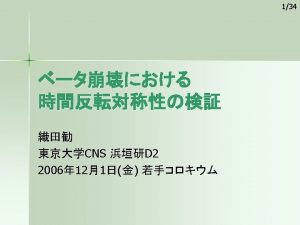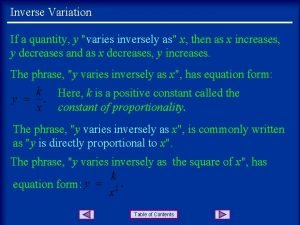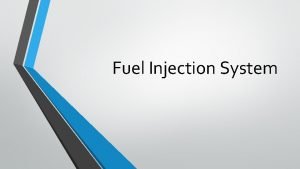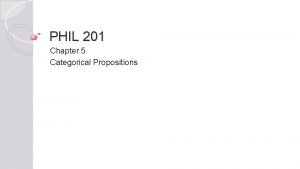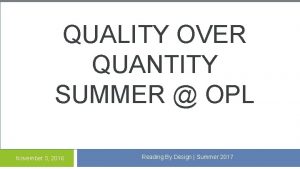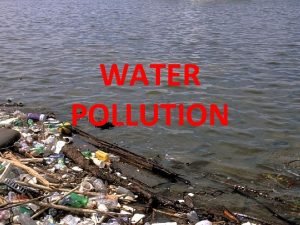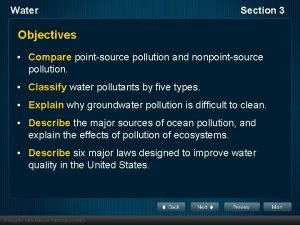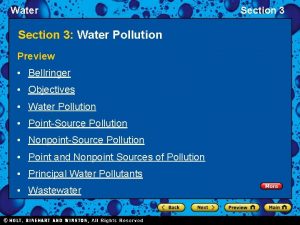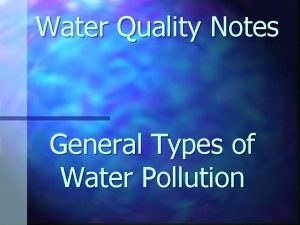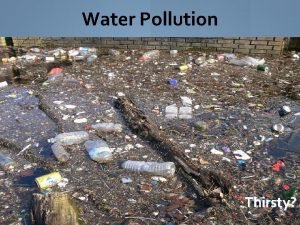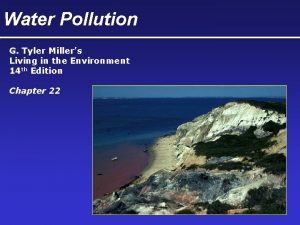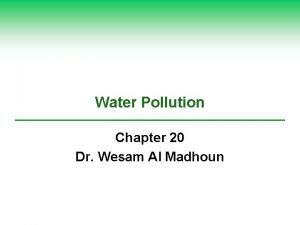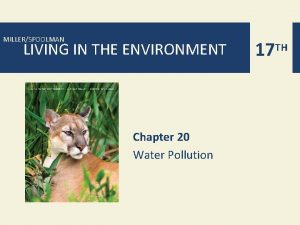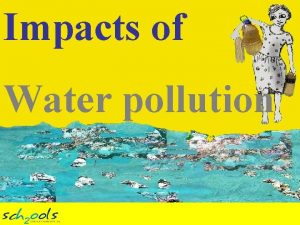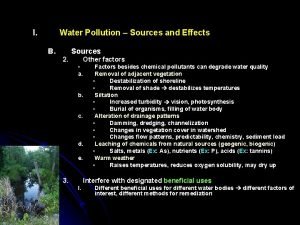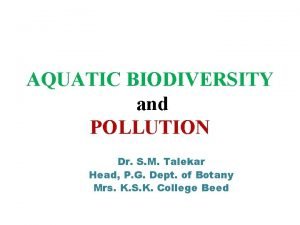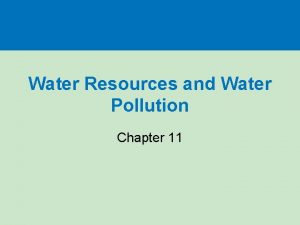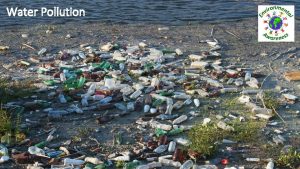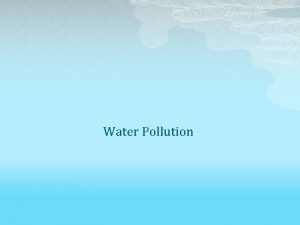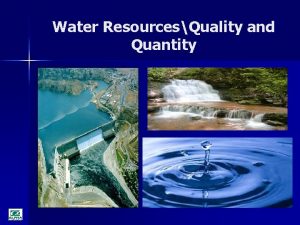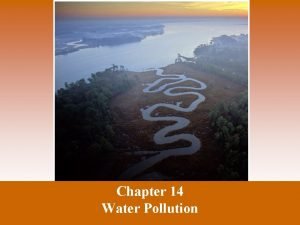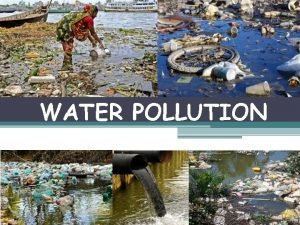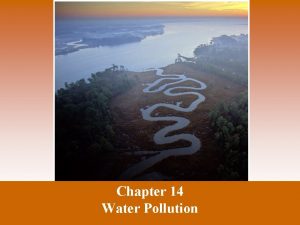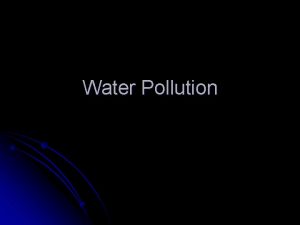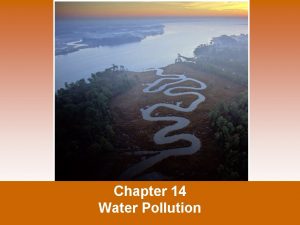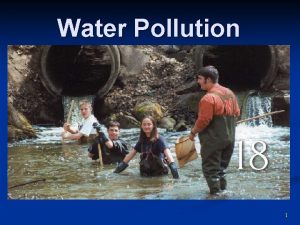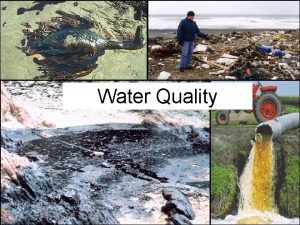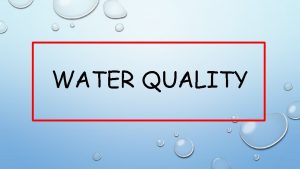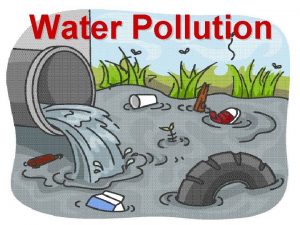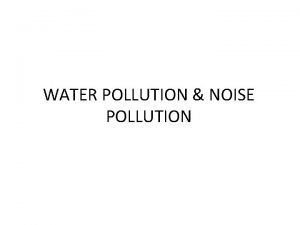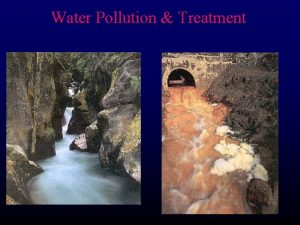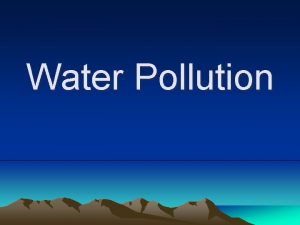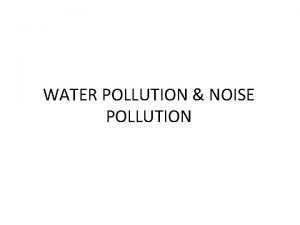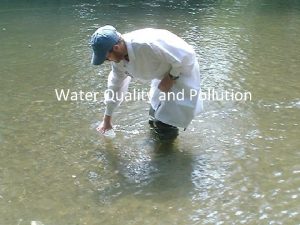Water Quantity and Quality What is Water Pollution









































- Slides: 41

Water Quantity and Quality

What is Water Pollution? any physical (temperature, oxygen), chemical (mercury), or biological (disease, sewage) change to water that adversely effects its use by living things

Cuyahoga River, Ohio Some river! Chocolatebrown, oily, bubbling with subsurface gases, it oozes rather than flows. "Anyone who falls into the Cuyahoga does not drown, " Cleveland's citizens joke grimly. "He decays. ” Time Magazine, August 1969 November 1952

Groundwater Pollution

Types of Water Pollution 1. Biological 2. Chemical 3. Physical Measured in: Percent (%) Parts per thousand (‰) Parts per million (ppm) Parts per billion (ppb)

Biological Water Pollution 1. Infectious Disease (Pathogens) 2. Oxygen-Demanding Waste Entamoeba histolytica Direct (microbes in water): Typhoid, cholera, dysentery, hepatitis…

Biological Water Pollution 1. Infectious Disease (Pathogens) 2. Oxygen-Demanding Waste Treehole mosquito (carried La Crosse ensephalitis) Indirect (Water breeding carriers): malaria, yellow fever, west nile virus…

Water Borne Disease

U. S. Water Borne Disease

Coliform Test Detection: Solutions: • Sewage treatment • Immunization

Biological Water Pollution 1. Infectious Disease (Pathogens) 2. Oxygen-Demanding Waste

Dissolved Oxygen Added by: turbulent water and photosynthesis Removed by: Increased temperature (exsolution) and respiration/decomposition Good: > 6 ppm (mosquitoes can survive in 1 ppm) (also measured in % of maximum - Good = 60 -80%)

Dissolved Carbon Dioxide Added by: respiration/decomposition & weathered rock Removed by: Increased temperature (exsolution) and photosynthesis Good: 1 -10 ppm (usually about 1 ppm)

Oxygen Sag

Measuring DO and other chemical properties

Chemical Water Pollution 3. Nutrients (Fertilizers) 4. Toxic Inorganic Materials 5. Persistent Organic Pollutants (POP’s) Nitrogen, phosphorous

Eutrophication Dissolved inorganic nitrogen in Baltic Sea & Blue Baby Syndrome

Nitrates • • • Typically: 0. 1 -4 ppm Unpolluted usually below 1 ppm Sewage pollution increase up to 20 ppm

Chemical Water Pollution 3. Nutrients (Fertilizers) 4. Toxic Inorganic Materials 5. Persistent Organic Pollutants (POP’s) 1. Heavy metals § mercury, lead, tin… 2. Super Toxic Elements § Arsenic, selenium… 3. Acids, salts, chlorine 4. Radioactive Isotopes

Arsenic in U. S. Waters

Some We Will Measure Copper • natural, fungicides, insecticides, copper pipes • can be lethal to some at 0. 1 ppb, algae – 1 -10 ppb, fish 500 ppb • water standard 0. 3 ppm Acidity (p. H) • 6. 5 -8. 2 normal (rainwater is usually a little acidic) • >9 – harmful to fish (inc. salmon) • <5. 5 releases metals in seds, bacteria die and organics don’t decay • <5 insects die and fish eggs don’t hatch • <4 lethal to adult salmon

Some We Will Measure Salinity • Saltwater 3. 5% • Freshwater 1 -500 ppm • usually >100 ppm is bad for freshwater organisms • >250 ppm tastes salty (max for drinking water) Total Dissolved Solids • (Ca, Mg, Hco 3, NH 4, NO 3, PO 4, SO 4, Na, Cl, Na, K) • from dissolved rock, fertilizer, urban runoff, irrigation, acid rainfall • “watchdog” – high numbers or rapid changes may indicate problem • typically 50 -250 ppm • Drinking water must be below 500 ppm

Chemical Water Pollution 3. Nutrients (Fertilizers) 4. Toxic Inorganic Materials 5. Persistent Organic Pollutants (POP’s)

Artificial Chemicals

The Dirty Dozen

Physical Water Pollution 6. Sediment 7. Thermal Pollution 8. Solid Waste Yellow River, China Chattahoochee River, GA

Measured in: NTU (Nephelometric • • Turbidity Units) Normal levels: 1 -50 NTU Drinking Water: 0. 5 -1 NTU Visible: >5 NTU Higher during storms

Physical Water Pollution 6. Sediment 7. Thermal Pollution 8. Solid Waste Causes: § industry § dams § removal of vegetation Optimum – Fish 5 -20°C (salmon <12°C)

Physical Water Pollution 6. Sediment 7. Thermal Pollution 8. Solid Waste

Pollution Sources: Point Source 1. 2. 3. 4. Sewage pipes Leaky gas tanks Industrial sites Injection wells

Pollution Sources: Nonpoint Source 1. 2. 3. 4. Agriculture (soil, fertilizer, pesticides) Urban runoff (from pavement) Construction sites Air Pollution

Controlling Water Quality What can we do?

Solutions 1. Legislation 2. Source Reduction 3. Improved Land Use Practices 4. Remediation 5. Sewage Treatment

Clean Water Act 1972 1. 2. 3. 4. 5. Established water quality standards System for ID’ing point sources Pretreatment for industry Federal funding for sewage treatment Provided for enforcement ü Worked well for point sources ü Nonpoint sources still a problem

Solutions 1. Legislation 2. Source Reduction 3. Improved Land Use Practices 4. Remediation 5. Sewage Treatment 1. 2. 3. 4. 5. Remove lead from gasoline Reduce road salting Decrease erosion Banning phosphates in detergents Reduce fertilizer use, etc.

Solutions 1. Legislation 2. Source Reduction 3. Improved Land Use Practices 4. Remediation 5. Sewage Treatment 1. 2. 3. 4. Stormwater treatment Reduce clearcutting Preserve wetlands Better construction practices

Solutions 1. Legislation 2. Source Reduction 3. Improved Land Use Practices 4. Remediation 5. Sewage Treatment

Solutions 1. Legislation 2. Source Reduction 3. Improved Land Use Practices 4. Remediation 5. Sewage Treatment Water hyacinths absorb arsenic

Solutions 1. Legislation 2. Source Reduction 3. Improved Land Use Practices 4. Remediation 5. Sewage Treatment West Point Treatment Plant, Seattle


Sewage in King County
 Examples of vector quantities
Examples of vector quantities Vector quantities
Vector quantities Scalar distance
Scalar distance Scalar quantity and vector quantity
Scalar quantity and vector quantity Water and water and water water
Water and water and water water Quantity y varies inversely as quantity x
Quantity y varies inversely as quantity x Difference between quality and quantity
Difference between quality and quantity Conversion, obversion and contraposition
Conversion, obversion and contraposition B. quality vs quantity
B. quality vs quantity Quality quantity
Quality quantity Quality over quantity
Quality over quantity Family time
Family time Perform quality assurance
Perform quality assurance Quality assurance concepts
Quality assurance concepts Effects of land pollution on human health
Effects of land pollution on human health Soil pollution images diagram
Soil pollution images diagram Water pollution and unequal distribution illustration
Water pollution and unequal distribution illustration Conclusion for pollution
Conclusion for pollution Objectives of water pollution
Objectives of water pollution Introduction for pollution
Introduction for pollution Quantity water
Quantity water Pmp quality vs grade
Pmp quality vs grade Pmbok quality management
Pmbok quality management Total quality management seminar
Total quality management seminar Quality improvement vs quality assurance
Quality improvement vs quality assurance Known as the fun uncle of the quality revolution
Known as the fun uncle of the quality revolution Quality is free: the art of making quality certain
Quality is free: the art of making quality certain Old quality vs new quality
Old quality vs new quality Source of contamination
Source of contamination Explain water pollution
Explain water pollution Type of reefs
Type of reefs Solution for water pollution
Solution for water pollution What are the terrible twelve water pollution
What are the terrible twelve water pollution Solutions to water pollution
Solutions to water pollution Air pollution consequences
Air pollution consequences Methods to control water pollution
Methods to control water pollution Effects of water pollution
Effects of water pollution Ddt water pollution
Ddt water pollution What are 5 effects of water pollution?
What are 5 effects of water pollution? Groundwater pollution
Groundwater pollution Conclusion of water pollution
Conclusion of water pollution Types of water pollution
Types of water pollution



